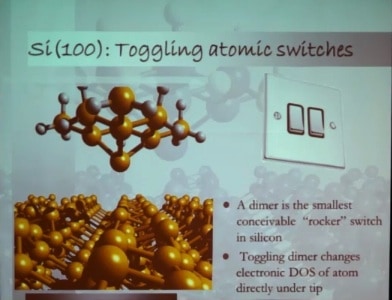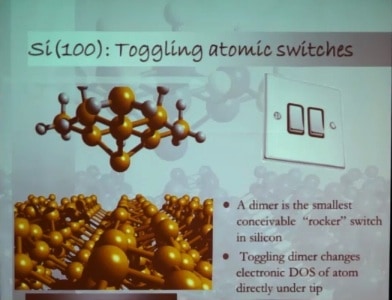
A select set of videos from the 2013 Foresight Technical Conference: Illuminating Atomic Precision, held January 11-13, 2013 in Palo Alto, have been made available on vimeo. Videos have been posted of those presentations for which the speakers have consented. Other presentations contained confidential information and will not be posted.
The 4th speaker in the Atomic Scale Devices session was Philip Moriarty. His talk was titled “Mechanical Atom Manipulation: Towards a Matter Compiler?” biography and abstract, video – video length 31:14.
Prof. Moriarty presented his work with the qPlus technique of non-contact AFM of semiconductors, using chemical forces to mechanically move atoms around to structure matter, focusing on the tip of the probe—specifically how to optimize the tip structure, and how to return the tip to a previously known state. He begins with a brief review of how non-contact AFM uses a damped, driven oscillator to measure and manipulate what is happening at the level of single chemical bonds. The tip at the end of the oscillating cantilever measures the frequency shift of the cantilever as it approaches and interacts with the surface, and it maintains a constant amplitude of oscillation by pumping energy into the system. The frequency shift provides information about conservative forces acting on the tip, and the amount of energy pumped in gives a handle on non-conservative, or dissipative, forces. Before diving into the experimental details of his own work, Prof. Moriarty noted that various experimental accomplishments have vindicated Eric Drexler’s assertion that single atom chemistry could be done using purely mechanical force.
The experiments Prof. Moriarty presented on the silicon (100) surface were typically done at either 5K or 77K, in ultra-high vacuum, using a tuning fork with a tungsten tip attached. The measurements were all done with zero electrical bias to focus on purely mechanical effects. The question addressed is whether manipulating Si atoms on a Si surface can be scaled down to the atomic level using just mechanical force. The Si(100) surface has the advantageous property of rearranging to eliminate dangling bonds. A charge transfer from one Si atom to another Si atom causes a buckling in the dimer rows to give a toggle switch of two Si atoms forming a ‘rocker’ switch, with one atom up and the other atom down. These structures are rigid at 5K, but start to flip back and forth at 100K, and at room temperature they are flipping at terahertz frequencies. Studies done in the mid-1990s suggested that some type of dimer logic might be possible with this system, depending on whether or not it would be possible to flip a single dimer. Another question is whether these dimers interact with each other—when one flips do you see correlations elsewhere? Would it be possible to go beyond storage to actually compute with such a system?
The question becomes: can one bring up an ATM tip to such a dimer and get the dimer to toggle? Calculations suggest that if the tip does not have the correct orbital symmetry, toggling a single dimer will be much more difficult. Experimentally, the question is whether it is possible to flip a single, pre-determined dimer, and are the flipped states stable? Are there longer-range interactions? The result is that bringing the tip in can flip one dimer by pulling the down atom up, but that change causes other dimers to flip because the dimers are coupled through the strain in the underlying lattice. Reversing the tip movement causes a reversion to the original state. However, dissipation forces in the AFM signal are variable due to rearrangements of atoms on the AFM tip with each cycle, at 25,000 cycles per second.
One way to obtain unambiguous tip structures is to stick a molecule, such as C60, to the tip, and then use a single dangling bond of a single adatom on a surface to image the exact atomic structure of the tip. This reverse of the usual imaging process is possible because the orbital on the surface is sharper than the orbitals on the tip. With C60 on the tip, the 5 atoms of the pentagon at the end of the tip are visible by non-contact AFM, and there is an asymmetry apparent depending on which face is pointing down.
When asked by a member of the audience about a program announced in 2008 to investigate the possibility of diamond mechanosynthesis (see also “Mechanical manipulation of silicon dimers on a silicon surface (video)“), Prof. Moriarty replied that diamond surfaces are very difficult to image and to create, so they have been working with some collaborators in Australia, and recent samples look promising. He emphasized that what they have learned from working with silicon surfaces, particularly tip control, will carry over to work on diamond surfaces.
Prof. Moriarty finished with a brief mention of automated procedures using a genetic algorithm to optimize probe tips, since even the sharpest tips change as they interact with a surface. February’s 2014 Foresight Technical Conference emphasizes Integration—the challenges of integration of nano-engineered devices and materials (“nanosystems”) into more complex micro- and macro-systems, across a wide range of applications. Registration is now open.
—James Lewis, PhD
